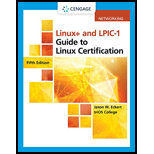1- Use the cat command to create a file. Name of this file should be file1. Type a few sentences in this file. Save this file. Use the cat command one more time to display the content of file1. 2- Use vi command to add more lines to this file so you can answer the rest of these questions that uses regular expressions and grep command. 3- Select the lines from file file1 that have exactly three characters in them. 4- Select the lines from file file1 that have at least three characters in them. 5- Select the lines from file file1 that have three or less characters in them. 6- Select the non-blank lines from the file file1. 7- Select the lines from file file1 that start with a capital letter. 8- Select the lines from file file1 that end with a period. 9- Select the lines from file file1 that have the string unix. 10- Select the lines from file file1 that end with the string unix.
1- Use the cat command to create a file. Name of this file should be file1. Type a few sentences in
this file. Save this file. Use the cat command one more time to display the content of file1.
2- Use vi command to add more lines to this file so you can answer the rest of these questions that
uses regular expressions and grep command.
3- Select the lines from file file1 that have exactly three characters in them.
4- Select the lines from file file1 that have at least three characters in them.
5- Select the lines from file file1 that have three or less characters in them.
6- Select the non-blank lines from the file file1.
7- Select the lines from file file1 that start with a capital letter.
8- Select the lines from file file1 that end with a period.
9- Select the lines from file file1 that have the string unix.
10- Select the lines from file file1 that end with the string unix.
11- Select the lines from file file1 that have only the string unix.12- Select the lines from file file1 that have the pattern unix at least two times.
13- Select the lines from file file1 that have the pattern unix and ends with unix.
14- Copy file file1 on the screen, but delete the blank lines.
15- Select the lines from file file1 that have a digit.
16- Select the lines from file file1 that have at least two digits without any other characters in
between.
May I get help with this problem, please? Mac terminal/Linux
Trending now
This is a popular solution!
Step by step
Solved in 3 steps







